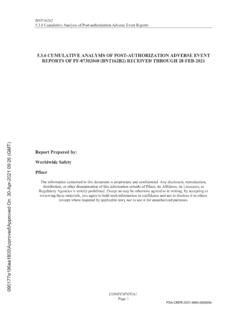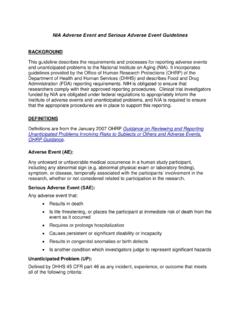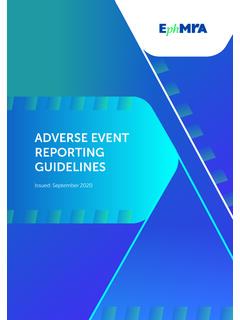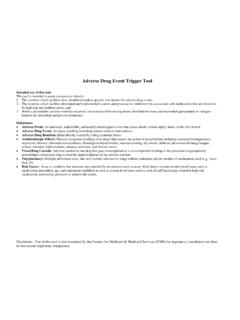Transcription of 5.3.6 CUMULATIVE ANALYSIS OF POST …
1 CUMULATIVE ANALYSIS of Post-authorization adverse Event ReportsCONFIDENTIALPage CUMULATIVE ANALYSIS OF POST-AUTHORIZATION adverse EVENT REPORTS OF PF-07302048 (BNT162B2) RECEIVED THROUGH 28-FEB-2021 Report Prepared by:Worldwide Safety PfizerThe information contained in this document is proprietary and confidential. Any disclosure, reproduction, distribution, or other dissemination of this information outside of Pfizer, its Affiliates, its Licensees, or Regulatory Agencies is strictly prohibited. Except as may be otherwise agreed to in writing, by accepting or reviewing these materials, you agree to hold such information in confidence and not to disclose it to others (except where required by applicable law), nor to use it for unauthorized \Approved\Approved On: 30-Apr-2021 09:26 (GMT) CUMULATIVE ANALYSIS of Post-authorization adverse Event ReportsCONFIDENTIALPage 2 TABLE OF CONTENTSLIST OF OF FIGURES.
2 3 APPENDICES ..3 LIST OF INTRODUCTION ..52. METHODOLOGY ..53. RESULTS .. Safety General Summary of Safety Concerns in the US Pharmacovigilance Plan .. Review of adverse events of Special Interest (AESIs) .. Medication error ..264. SUMMARY AND CONCLUSION ..29090177e196ea1800\Approved\Approved On: 30-Apr-2021 09:26 (GMT) CUMULATIVE ANALYSIS of Post-authorization adverse Event ReportsCONFIDENTIALPage 3 LIST OF TABLEST able Overview: Selected Characteristics of All Cases Received During the Reporting Reported in 2% Identified Potential of Missing Information ..12 Table Evaluation for PTs by seriousness with or without harm co-association (Through 28 February 2021).
3 27 LIST OF FIGURESF igure Number of 13vPnC AEs by System Organ Classes and Event Seriousness ..8 APPENDICESAPPENDIX 1 LIST OF adverse events OF SPECIAL INTEREST ..30090177e196ea1800\Approved\Approved On: 30-Apr-2021 09:26 (GMT) CUMULATIVE ANALYSIS of Post-authorization adverse Event ReportsCONFIDENTIALPage 4 LIST OF ABBREVIATIONSA cronymTermAEadverse eventAESI adverse event of special interestBCBrighton CollaborationCDCC enters for Disease Control and PreventionCOVID-19coronavirus disease 2019 DLPdata lock pointEUAemergency use authorisationHLGT(MedDRA) High Group Level TermHLT(MedDRA) High Level TermMAHmarketing authorisation holderMedDRAmedical dictionary for regulatory activitiesMHRAM edicines and Healthcare products Regulatory AgencyPCRP olymerase Chain ReactionPT(MedDRA)
4 Preferred TermPVPpharmacovigilance planRT-PCRR everse Transcription-Polymerase Chain ReactionRSIreference safety informationTMEtargeted medically eventSARS-CoV-2severe acute respiratory syndrome coronavirus 2 SMQstandardised MedDRA querySOC(MedDRA) System Organ ClassUKUnited KingdomUSUnited StatesVAED vaccine-associated enhanced diseaseVAERD vaccine-associated enhanced respiratory diseaseVAERS vaccine adverse event reporting system090177e196ea1800\Approved\Approved On: 30-Apr-2021 09:26 (GMT) CUMULATIVE ANALYSIS of Post-authorization adverse Event ReportsCONFIDENTIALPage 51. INTRODUCTIONR eference is made to the Request for Comments and Advice submitted 04 February 2021 regarding Pfizer/BioNTech s proposal for the clinical and post-authorization safety data package for the Biologics License Application (BLA) for our investigational COVID-19 Vaccine (BNT162b2).
5 Further reference is made to the Agency s 09 March 2021 response to this request, and specifically, the following request from the Agency. Monthly safety reports primarily focus on events that occurred during the reporting interval and include information not relevant to a BLA submission such as line lists of adverse events by country. We are most interested in a CUMULATIVE ANALYSIS of post-authorization safety data to support your future BLA submission. Please submit an integrated ANALYSIS of your CUMULATIVE post-authorization safety data, including and foreign post-authorization experience, in your upcoming BLA submission.
6 Please include a CUMULATIVE ANALYSIS of the Important Identified Risks, Important Potential Risks, and areas of Important Missing Information identified in your Pharmacovigilance Plan, as well as adverse events of special interest and vaccine administration errors (whether or not associated with an adverse event). Please also include distribution data and an ANALYSIS of the most common adverse events . In addition, please submit your updated Pharmacovigilance Plan with your BLA submission. This document provides an integrated ANALYSIS of the CUMULATIVE post-authorization safety data, including and foreign post-authorization adverse event reports received through 28 February METHODOLOGYP fizer is responsible for the management post-authorization safety data on behalf of the MAH BioNTech according to the Pharmacovigilance Agreement in place.
7 Data from BioNTech are included in the report when s safety database contains cases of AEs reported spontaneously to Pfizer, cases reported by the health authorities, cases published in the medical literature, cases from Pfizer-sponsored marketing programs, non-interventional studies, and cases of serious AEs reported from clinical studies regardless of causality limitations of post-marketing adverse drug event reporting should be considered when interpreting these data: Reports are submitted voluntarily, and the magnitude of underreporting is unknown. Some of the factors that may influence whether an event is reported include: length of time since marketing, market share of the drug, publicity about a drug or an AE, seriousness of the reaction, regulatory actions, awareness by health professionals and consumers of adverse drug event reporting, and litigation.
8 Because many external factors influence whether or not an AE is reported, the spontaneous reporting system yields reporting proportions not incidence rates. As a result, it is generally not appropriate to make between-drug comparisons using these 090177e196ea1800\Approved\Approved On: 30-Apr-2021 09:26 (GMT) CUMULATIVE ANALYSIS of Post-authorization adverse Event ReportsCONFIDENTIALPage 6proportions; the spontaneous reporting system should be used for signal detection rather than hypothesis testing. In some reports, clinical information (such as medical history, validation of diagnosis, time from drug use to onset of illness, dose, and use of concomitant drugs) is missing or incomplete, and follow-up information may not be available.
9 An accumulation of adverse event reports (AERs) does not necessarily indicate that a particular AE was caused by the drug; rather, the event may be due to an underlying disease or some other factor(s) such as past medical history or concomitant medication. Among adverse event reports received into the Pfizer safety database during the CUMULATIVE period, only those having a complete workflow cycle in the safety database (meaning they progressed to Distribution or Closed workflow status) are included in the monthly SMSR. This approach prevents the inclusion of cases that are not fully processed hence not accurately reflecting final information.
10 Due to the large numbers of spontaneous adverse event reports received for the product, the MAH has prioritised the processing of serious cases, in order to meet expedited regulatory reporting timelines and ensure these reports are available for signal detection and evaluation activity. The increased volume of reports has not impacted case processing for serious reports, and compliance metrics continue to be monitored weekly with prompt action taken as needed to maintain compliance with expedited reporting obligations. Non-serious cases are entered into the safety database no later than 4 calendar days from receipt.















